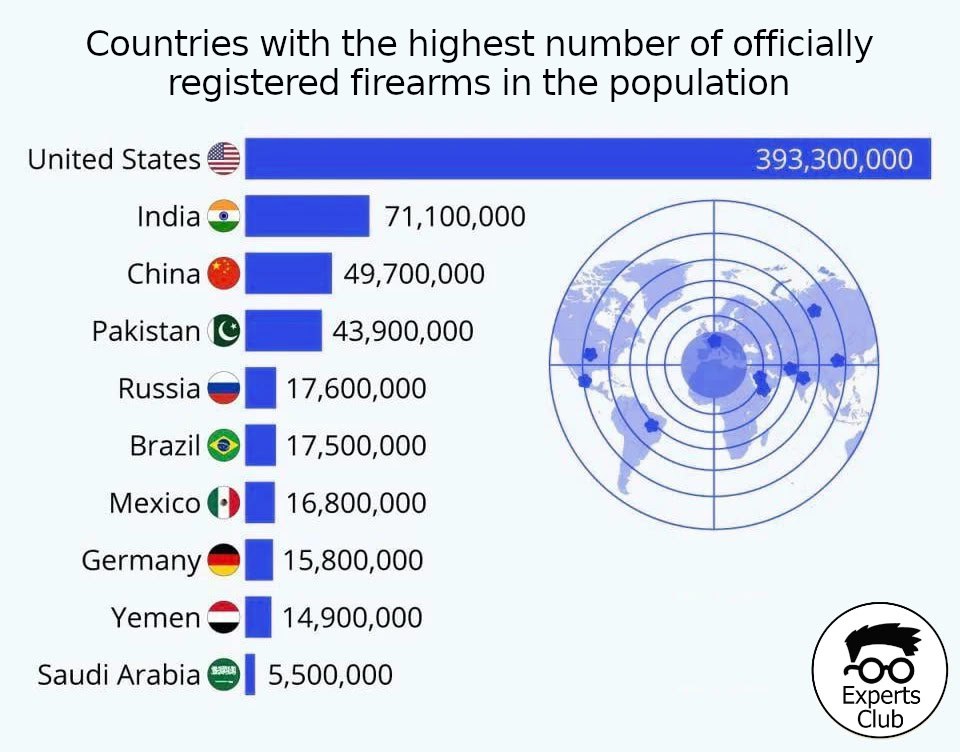
The global ranking of armed populations, compiled on the basis of the Small Arms Survey, shows that the ten countries with the largest number of civilian weapons include the United States, India, China, Pakistan, Russia, Brazil, Mexico, Germany, Yemen, and Saudi Arabia. Ukraine is not on this list, but even before Russia’s full-scale invasion, the country was among the states with a significant amount of weapons in the hands of citizens. The Experts Club Analytical Center analyzed global and Ukrainian statistics.
According to the Small Arms Survey for 2017-18, there were about 4.4 million civilian weapons in Ukraine—approximately 9.9 guns per 100 inhabitants. Of these, only about 800,000 were officially registered, and about 3.6 million belonged to the illegal segment.
According to the National Police database, as of July 31, 2018, there were 892,854 registered weapons in the country. In 2021, the Ministry of Internal Affairs estimated the number of weapons legally owned by citizens at approximately 1.3 million, against the backdrop of tighter regulations and growing public interest in self-defense after 2014.

The full-scale war of 2022 dramatically changed the picture. Against the backdrop of the formation of territorial defense and volunteer units, the state massively transferred small arms to citizens; at the same time, a significant number of captured and illegal firearms ended up in the hands of the population. Estimates today vary widely: according to Interior Minister Ihor Klymenko, Ukrainians may have between 1 and 5 million weapons, while a number of think tanks put the figure at 4–5 million, of which 2–3 million may be in illegal circulation.
Research by Small Arms Survey using sociological surveys shows that up to 11% of Ukrainian households may have at least one weapon, which on a national scale gives a range of 865,000 to 1.42 million armed households. At the same time, the share of households that openly report the presence of weapons in 2023–2024 remains at 5–6%, which indicates both a high level of distrust and the sensitivity of the issue in wartime.
To bring order, Ukraine has launched a Unified Weapons Register. By July 2024, 63% of households that own weapons stated that some or all of their weapons were registered; among those who are aware of the system, 74% claim to have registered all their weapons, but about 10% continue to keep unregistered weapons.
Thus, while before the war there were approximately 1.3 million registered weapons in Ukraine and several times more illegal firearms, now, against the backdrop of full-scale hostilities, there are millions of weapons, a significant portion of which must gradually be registered or confiscated.
This makes the issue of civilian weapons control one of the key issues for post-war security, law enforcement reform, and Ukraine’s negotiations with the EU on the harmonization of weapons legislation.
Source: https://expertsclub.eu/ukrayina-na-tli-svitovogo-rynku-czyvilnoyi-zbroyi/

As part of the Prioritized Ukraine Requirements List (PURL) program, Poland will allocate $100 million for the purchase of American weapons for Ukraine. The purchases will be financed from the budget of the Polish Ministry of Foreign Affairs, said the head of the ministry, Radosław Sikorski.
“Europe’s security will be enhanced or diminished as a result of how this war ends,” Sikorski stressed, according to Polsat News.
As reported, the initiative to finance the purchase of American weapons for Ukraine came after the US administration refused to continue supplying weapons to Kyiv free of charge. In August, four packages of American weapons were prepared for a total amount of about $2 billion. The funding was provided by Germany, Denmark, Canada, the Netherlands, Norway, and Sweden.
On August 15, at a meeting of NATO defense ministers in Brussels, Estonia, Latvia, Lithuania, Belgium, Luxembourg, Finland, and Iceland announced their decision to join the program to finance Ukrainian defense orders within the framework of the NATO initiative “Priority Urgent Requirements List for Ukraine” (PURL).
On October 23, Spain announced its agreement to join the PURL project in response to renewed criticism from US President Donald Trump regarding Spain’s unwillingness to increase military spending.

Beijing has never provided weapons to either side of the Ukrainian conflict and does not intend to tolerate G7 attempts to put the blame on China, Chinese Foreign Ministry spokesman Lin Jian said on Thursday.
“China has always been open and honest about the Ukrainian crisis, has not provided lethal weapons to either side of the conflict, strictly controls dual-use goods and will never accept the G7’s attempts to shift blame or label China,” the Global Times quoted a Foreign Ministry spokesman as saying.
Lin Jian commented on the statement of the G7 foreign ministers, in which the ministers condemned Beijing for allegedly transferring weapons and dual-use goods to Moscow.
The Foreign Ministry spokesman noted that the authors of the statement ignored the facts and deliberately vilified China, interfering in the internal affairs of the country. He emphasized that Beijing is extremely dissatisfied with such a position of the G7 and strongly opposes the statement.
In a joint statement issued on Thursday night, the G7 foreign ministers condemned countries they believe are supporting Russia in its war against Ukraine.
“We condemn the provision of military support to Russia by the DPRK and Iran, as well as the provision of arms and dual-use goods by China,” the statement said.
The ministers also expressed concern over the “military build-up by the Chinese army” and “unilateral attempts to change the status quo, in particular by force or coercion” in the East China Sea and South China Sea.

Ukraine will open offices in Berlin and Copenhagen this year to sell arms for export, Ukrainian President Volodymyr Zelenskyy has announced.
“We are opening two export capitals. You know that this is co-production and export, which we talked about, of weapons that we can afford to sell in order to have additional money for our domestic production of scarce items, for which we do not have enough money,” Zelensky said at a briefing on Monday.
According to the president, the opening of the first two representative offices was decided not at the level of companies that will be involved in co-production, but at the level of states.
“The first two capitals are our representative offices, Berlin and Copenhagen. This will happen this year,” the president added.

The Finnish government has decided to allocate €100 million for the purchase of weapons from the US for transfer to Ukraine, Prime Minister Petteri Orpo announced on Thursday.
“On Thursday, the government decided to allocate €100 million to support Ukraine by purchasing weapons from the US. This is a NATO-coordinated support package called PURL. Finland is participating in a joint support package for the Baltic and Northern European countries, which is planned to be delivered to Ukraine in the near future,” the Finnish prime minister said, as quoted by the Helsingin Sanomat newspaper.
“The situation in Ukraine is critical. Yes, we must participate. We cannot stand aside when all the countries of Northern Europe and the Baltic States are involved,” he stressed.
According to Orpo, the funding will be provided through external borrowing and Finland’s budget will not be revised, “even though it will increase the debt.”
The initiative to finance the purchase of American weapons for Ukraine came after the US administration refused to continue supplying weapons to Kyiv free of charge. In August, four packages of American weapons were prepared for a total amount of about $2 billion. The financing was provided by Germany, Denmark, Canada, the Netherlands, Norway, and Sweden.
On August 15, at a meeting of NATO defense ministers in Brussels, Estonia, Latvia, Lithuania, Belgium, Luxembourg, Finland, and Iceland announced their decision to join the program. In October, Spain also announced its participation.

Spain has agreed to join the PURL project to purchase American weapons for Ukraine, Prime Minister Pedro Sánchez said in response to renewed criticism from US President Donald Trump over Spain’s unwillingness to increase military spending.
“We are a reliable country,” Sanchez said upon arrival at the European Council, where he also confirmed that Spain would purchase weapons from the US for Ukraine, El Pais reported on Thursday.
According to the publication, the country will participate in the US arms supply program (PURL), but the exact amount that Madrid is willing to spend has not yet been determined.